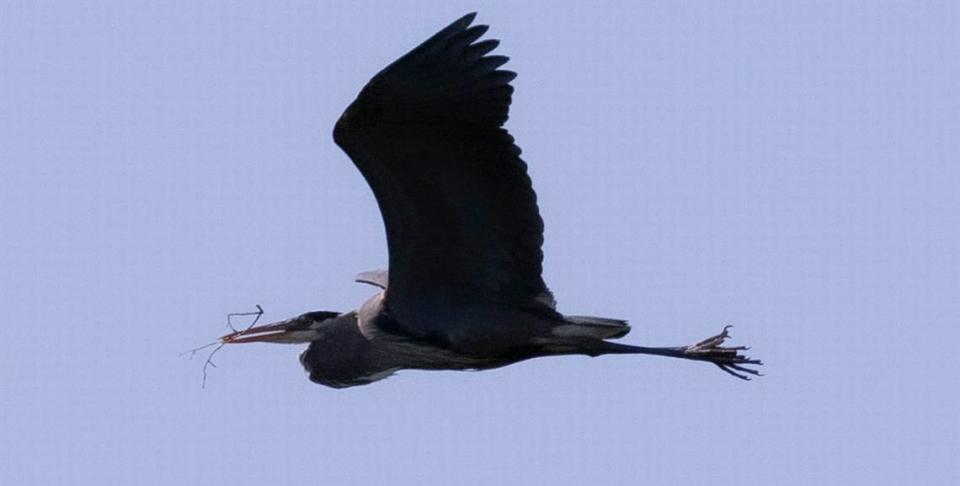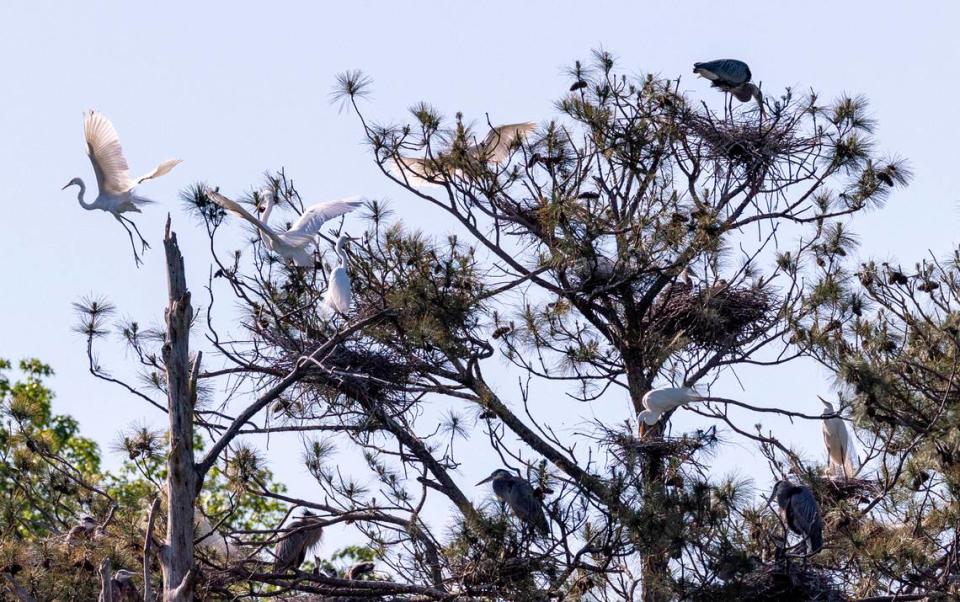State proposes preserving Durham heron nesting grounds. The city isn’t so sure.
The large, stick-built nests sit high in pines above the marsh, which is alive with croaking frogs, quarreling geese and the calls of insects.
Great blue herons and great egrets make great loops as they glide toward their young, awaiting a meal, their squawks wild and loud.
Last year, the Ellerbe Creek Watershed Association counted more than 160 nesting herons and egrets in a rookery 10 minutes north of downtown Durham.
For Sarah Fitzpatrick, a volunteer seeing the rookery for the first time Wednesday, it was better than she ever imagined.
“You don’t necessarily think of Durham as a great habitat and then you take a walk through the woods and find something majestic,” she reflected on the hike back.

City owns the land
The city owns several hundred acres along Ellerbe Creek north of downtown, including the beaver pond the egrets and herons call home.
Last year, the state of North Carolina joined the Ellerbe Creek Watershed Association (ECWA) in proposing the city dedicate 284 acres around the waterbird colony as a nature preserve.
The move would permanently conserve the land, but city staff members are hesitant.
“That alternative would give the city extremely limited use of its property,” real estate administrator David Fleischer told the City Council in a work session Thursday.
The city would have trouble maintaining or adding utility infrastructure through the land if it is preserved, Fleischer explained. The boundary abuts the city’s closed landfill and one of its current wastewater treatment plants.
Plus, transportation agencies eventually plan to bisect the site with a Northern Durham Parkway, he noted. The city also considers 35 acres “developable.”
In two dozen meetings since last January, the state proposal shrank to 83 strictly managed acres surrounded by a buffer for a 215-acre total.
City staff, however, recommend it be registered as a heritage area, not dedicated as a nature preserve.
A dedicated nature preserve can only be undone by the Council of State, while a registered heritage area can be reversed or shrunk by the City Council

“The whole point of permanent conservation is for it to be permanent,” ECWA executive director Rickie White later countered. “We want to prevent future folks from coming in and developing this section of the property, which is 80% wetland, by the way.”
The City Council will vote on how to proceed May 1.
‘Regionally important’
Chris Dreps is the land protection director at ECWA. He said they stumbled upon the area years ago — likely in the early 2000s, soon after the association’s founding — and quickly recognized how special it was.
It’s about as far west as great egrets breed in North Carolina, according to the National Audubon Society. State wildlife agents have observed great blue heron nests in most counties east of the mountains.
“This isn’t just a cool place,” Dreps told The News & Observer. “It’s regionally important and really special,
Both bird species are plentiful in the wild, though researchers say habitat loss and fragmentation may one day threaten Piedmont populations.
So about five years ago, the ECWA began pushing harder for preservation, this time asking the state’s Natural Heritage Program to take a look. The state agency joined the push for conservation.

“They think this place is important enough to become a dedicated nature preserve,” Dreps said.
Juilee Malavade is chair of the city’s Environmental Affairs Board, which also recommends preservation. She said the breeding grounds are impressive, as is the site’s ability to help limit flooding and runoff after heavy rains.
“Protecting wetlands is so important,” Malavade said. “Most importantly, we were interested in what kind of stormwater protection it would provide.”
City staff expect it would cost $100,000 to preserve. Grants may help cover that.
If the city were to vote to dedicate the land as a nature preserve, the state’s executive branch must approve it. A management plan would be required that could one day allow for easier public access, Dreps said.
“Today, you really have to go on a guided hike to get there,” he said. “The average person couldn’t find it.”
An obscure hike
The ECWA took a small group of city and county staff members and the Environmental Affairs Board on a hike to see the rookery Wednesday.
The group trekked through Glennstone Nature Preserve onto Army Corps of Engineers Land and past a privately owned car graveyard to reach the marsh the birds call home.
They brought a scope and set it up in the clearing as startled wood ducks took flight.
Great blue herons and great egrets both have long and sharp bills, perfect for spearing prey. They are often seen fishing in shallow water, wading on long spindly legs.
“Great blue herons are kind of the star of the show out there. They’re huge birds,” Dreps said.
The species nests in groups for protection, as they’re not especially fast. Beaver dams help craft the perfect habitat.

The waterbirds typically arrive by March and leave in early summer. The young are currently half the size of their parents, though White says they’ll be fully grown by the end of May, just in time for ECWA’s annual Memorial Day hikes.
“They’ll look really similar, just more awkward, and they’re still begging for food,” White said.
As the crew walked back to their cars in the warm 5 p.m. light, Dreps turned to a city staffer, smiling:
“I mean shouldn’t this be protected?”

